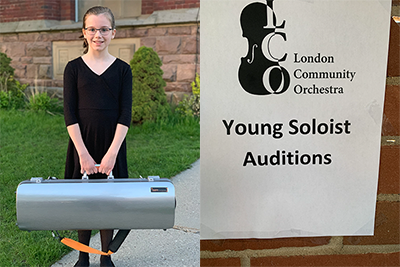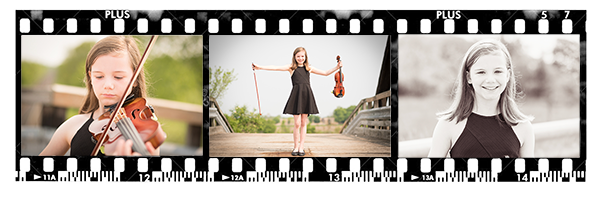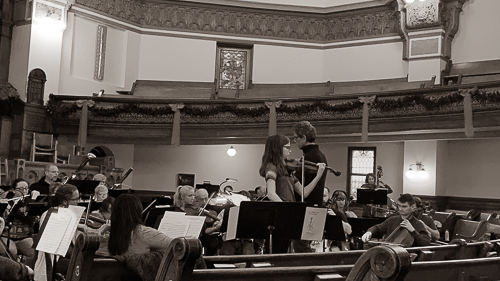So you want to solo with orchestra: 10 tips for a successful performance
A solo appearance with orchestra is regarded as a highlight in the life of a young artist. Here are a handful of tips to prepare for a great experience.

As kids begin playing longer and more complex works, opportunities to perform with orchestra emerge. When my daughter had such an opportunity last year, it was a chance for us to reflect on how we prepared and what we learned from the experience. What follows is a description of what we experienced along with lessons that we learned in the form of 10 tips for a great performance with orchestra. (Feel free to jump to the tips!)
How it unfolded for us
We started to discuss the idea of a solo appearance in the March of the year preceding the December concert. My daughter happened to have two suitable works in her repertoire at the time - the first movement of a classical concerto and a concert piece. We were unsure which to audition. The concerto movement was already well-prepared; but it would mean learning the second and third movements (and cadenzas) to an equally high level over the busy summer months. The concert piece was shorter but technically more challenging. In the end, her teacher explained the dilemma to the conductor. His recommendation was to audition both pieces so that he and the audition panel could possibly work with either option. I think we made the final decision of what to audition the day before!^[Both works were ready to go; but it did add a little uncertainty to the equation!]
On the audition day, we arrived at the hall about 45 minutes before the scheduled audition time and were greeted by a member of the orchestra. We were guided to a practice room where we were able to warm up by playing through both of the works. As the scheduled audition time approached, we were led to the green room. (I should emphasize that I was with my daughter, age 11, the whole time because I’m also her collaborative pianist. In other settings, it would have worked slightly differently.)
As the preceding candidate completed her audition, a member of the committee came to the green room, confirmed our names and the work(s) to be auditioned and were led into the hall. The audition committee consisted of about 15 or more members of the orchestra and, of course, the conductor. My daughter introduced herself and her works. She played them well, the committee applauded and we left with smiles on our faces.
Then we waited. And waited. Some weeks later an email arrived. She was invited to solo with the orchestra that December. Now, a flurry of activity getting everything together that the orchestra would need for publicity and for the program. She had a contract to sign in order to make her commitment official. Then a biographical sketch for the program, and publicity photographs. Since we wanted a photographer who was familiar with photographing young artists, we reached out to a friend whose daughter soloed the prior year and found an excellent candid photographer.
What followed was six months of preparation. We worked on her chosen work every single day until the concert. Sometimes, we would play through the entire work. Sometimes we would work on small sections and sometimes we would do both. She played the piece on recitals 2-3 times again before the concert and she played it for three different master classes. At about three months before the concert, she and her mom worked on finding just the right gown for the concert. Of course they wanted something attractive but also something that would not restrict her freedom of motion when playing.
About a month before the concert, the conductor and concertmaster asked for her bowed part so that the orchestra could be consistent.
Finally as the performance date approached, she had three scheduled rehearsals with the orchestra. The conductor allocated about 20 minutes of rehearsal time each of the three sessions. It was all very efficient.
Finally the concert day arrived. Along with a young artist full of nerves, we arrived about an hour before the performance. Finally after over a year of preparation, she strode onto the stage, took her bow and before we knew it, it was all over.
What did we learn from the experience? 10 tips to prepare for a great day.
1. Balance a competitive attitude with a spirit of acceptance
This is difficult. For students who have grown up in the world of Suzuki talent education, explicit competition is not part of their experience. We approached it carefully with our daughter. She has always wanted to solo with orchestra, so her motivation was high. But we also recognized that the orchestra might shy away from the risk of playing with someone so young. We simply said: “Do your best and realize that the audition committee takes into consideration so many variables…” In any case, we avoided the idea that she was competing against other young people. She was offering her best self.^[This is a subject that could fill volumes. I know that there are differences of opinion out there. For example, Nathan Cole, the associate concertmaster of the Los Angeles Philharmonic has written about auditions and I’ve had follow-up conversations with him online. His feeling is that you audition to win, not to “just see how the experience is." Another way of thinking about competitions is to say to yourself: “Look, the organizers have a problem that they need to solve; they need to identify a winner. I’m going to do everything I can to show them why I’m the solution to their needs. But in the end, they may find another solution." Somewhat tangentially related to this idea of letting go of the results is this brief interview with actor Bryan Cranston on auditions.]
2. Choose the repertoire wisely
Do your research. If the orchestra has played the Bruch G minor concerto recently, this is probably not the right choice. Young artist concerts are partly offered to support young people, but the orchestra still has paying patrons who don’t necessarily want to hear the same work every year. She played the Beethoven G major Romance, Op. 40. Serendipitously, this season in our orchestra, as around the world, the 250th birthday of the master is being celebrated. It turns out that having the Beethoven ready to go, allowed the orchestra to slot her work into a larger theme for the season. We didn’t really anticipate this; but it probably worked in her favour.
3. Practice effectively
There are three simultaneous challenges that you will have to contend with. The preparation process is lengthy. For a major concerto, it may require two years. It requires you to obsess over tiny details. But this goes on for so long, you cannot drop everything else. Your musical life goes on. It’s a constant process of balancing your practice between the performance work and everything else.
The second challenge is in finding the balance between playing the piece as a whole vs. turning the microscope on the small challenging details. Too much focus on the details and the piece turns into an etude devoid of the character that tells a complete story. Too much emphasis on playing through the entire piece means that while the memory may be very secure, there may be under-practiced small glitches that never get solved.
Finally, burnout is a risk. So is the risk that the piece will lose some of the expressive character that is needed to make it shine and sparkle over the orchestra. How to keep it fresh? We found that is was helpful to refer back to the metaphors that first enlivened the piece. With her Beethoven, we were constantly talking about the composer’s stormy and sometimes tragic life. With Haydn, we could talk about the composer’s sophisticated jokes. With Mozart, his operatic melodrama.
We resolved the challenges of time management by deciding to play through the entire work once a week. As the concert approached, we shifted the majority of our attention to the upcoming work to be performed. At about two weeks before the concert, we began to play through the piece daily in its entirety and doing section practice.
4. Air the piece as often as possible
Take every single opportunity to play the piece in public. If not opportunity exists, make one. Play it for friends. Invite people over. Be completely familiar and relaxed with the piece. Video yourself and take note of everything - tone quality, pacing, posture.
5. Know the score
By the time the first rehearsal arrives, the young player will hopefully have had the experience of playing the piece in public in different venues. But each of these performances will be with her collaborative pianist. The orchestral score will often be quite different. The piano is versatile instrument, but nothing can replace, say, a bassoon. It’s vital that you listen to many recordings of your work with orchestra. It is equally vital that you follow the score along with the recordings. Very often these orchestral scores are available on IMSLP. Do not simply rely on the piano part which is an orchestral reduction. By understanding who will be playing behind you on stage, how the parts interweave, you’ll have a firmer idea of how the music unfolds. Know the score.
6. Be assertive and communicative with the conductor and concertmaster
This may be difficult for young artists appearing for the first time. Conductors who are experienced at working with young people will anticipate this and work with the student and teacher to iron out any points in the score where they need to take some liberties.
7. Mentally prepare for the performance
Playing with the orchestra will challenge the nerves in ways that playing in a performance class for peers will not. The hall is larger. The audience is larger. The sounds is bigger. In the weeks leading up to the concert date, we talked frequently about mental preparation. Think about the following:
- How will you enter and exit the stage? When do you shake hands? With whom do you shake hands?
- At what points in the piece do you need to cue the conductor about your intent?
- Where will you look during the performance? (We picked a particular spot in the hall.)
- What will you do during the tutti sections?
- Do I need to project more as a soloist?
8. Don’t wait until the last minute
Try to get as much done up-front as possible. You will need a biographical sketch and a headshot. Schedule a photographer right away. Begin writing your biographical material early so that there is time to edit it collaboratively with the teacher and others. Most importantly, prepare the music. Don’t avoid any difficult corners. Confront them head-on!
In the two weeks before the concert, if you are a string player, consider replacing your strings. You can also use the preceding several months to evaluate different strings. On my daughter’s instrument for example, we tried Dominants, Evah Pirazzi, and Obligato during the year leading up to the concert, before finally settling on Evah Pirazzi. But don’t wait too long, some strings take a long time to settle. Two weeks is ideal for the tuning to settle and for an initial hyper-brilliance to mellow a bit. And keep the old strings in case disaster strikes!
9. Ask about video
If you are playing with a professional orchestra, you will need permission to record the performance. Explain why you want to record or video the performance. Mention up-front why you want it. In our case, we knew that an audition video was due within the month. Finally, if they grant permission to record the performance for a narrowly restricted purpose, keep your word and don’t post it on social media. Building goodwill with the orchestra will serve you and others well.
10. Be prepared for an emotional vacuum that follows
Her teacher told us to anticipate the feeling of withdrawal that would follow. It was hard for us to really tease out why we felt that way, but it was an unmistakable feeling of emptiness. Her performance had been wonderful and the experience of preparing that intensely was invaluable. But then there was nothing more. It may last for a few weeks, but giving everyone in the family a chance to experience it each in her own way is important.
The experience was intense, rewarding, and in a sense validating. You begin to glimpse the level of preparation and commitment that are required to do this professionally. For the better part of a year, this consumed a large part of our family life. Would she do it again? Absolutely!
N.B. I would be negligent if I failed to mention that many, if not most of these ideas originate with her teacher, Irene Tandberg, to whom we are forever grateful.









